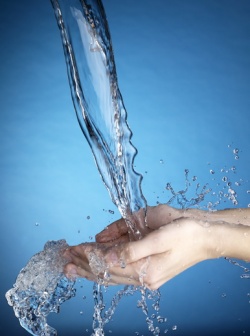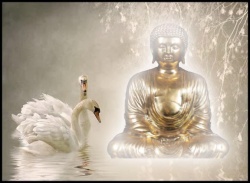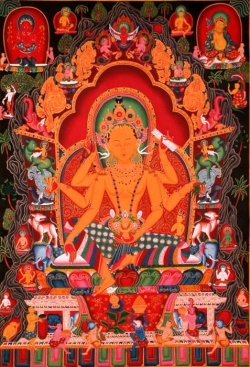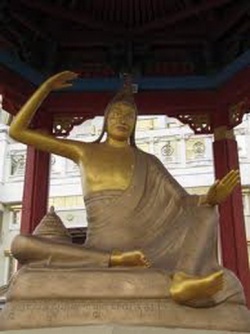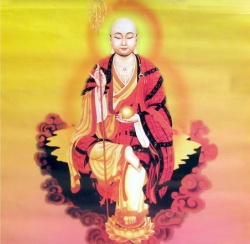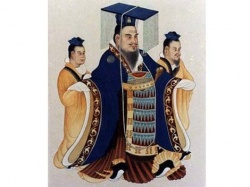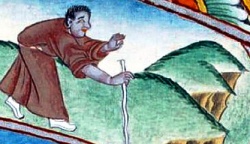Pranayama
(pranayama); Breath control ;
Prāṇāyāma (Sanskrit: प्राणायाम prāṇāyāma) is a Sanskrit word meaning "extension of the prāṇa or breath" or "extension of the life force". The word is composed from two Sanskrit words: prana meaning life force (noted particularly as the breath), and ayāma, to extend or draw out. (Not "restrain, or control" as is often translated from yam instead of ayāma). It is a yogic discipline with origins in ancient India.
Prāṇāyāma (Devanagari: प्राणायाम prāṇāyāma) is a Sanskrit compound.
V. S. Apte provides fourteen different meanings for the word prāṇa (Devanagari: प्राण, prāṇa) including these:
Breath, respiration
The breath of life, vital air, principle of life (usually plural in this sense, there being five such vital airs generally assumed, but three, six, seven, nine, and even ten are also spoken of)
Energy, vigor
The spirit or soul
Of these meanings, the concept of "vital air" is used by Bhattacharyya to describe the concept as used in Sanskrit texts dealing with prāṇāyāma.
Thomas McEvilley translates prāṇa as "spirit-energy". Its most subtle material form is the breath, but is also to be found in blood, and its most concentrated form is semen in men and vaginal fluid in women.
Monier-Williams defines the compound prāṇāyāma as "(m., also pl.) N. of the three 'breath-exercises' performed during Saṃdhyā (See pūrak, rechak (English: retch or throw out), kumbhak".
This technical definition refers to a particular system of breath control with three processes as explained by Bhattacharyya: pūrak (to take the breath inside), kumbhak (to retain it), and rechak (to discharge it). There are also other processes of prāṇāyāma in addition to this three-step model.
Macdonell gives the etymology as prāṇa + āyāma and defines it as "m. suspension of breath (sts. pl.)".
Apte's definition of āyāmaḥ derives it from ā + yām and provides several variant meanings for it when used in compounds. The first three meanings have to do with "length", "expansion, extension", and "stretching, extending", but in the specific case of use in the compound prāṇāyāma he defines āyāmaḥ as meaning "restrain, control, stopping".
An alternative etymology for the compound is cited by Ramamurti Mishra, who says that:
Expansion of individual energy into cosmic energy is called prāṇāyāma (prāṇa, energy + ayām, expansion).
Prāṇāyāma is mentioned in verse 4.29 of the Bhagavad Gītā.
According to Bhagavad-Gītā As It Is, prāṇāyāma is translated to "trance induced by stopping all breathing", also being made from the two separate Sanskrit words, prāṇa and āyām.
Pranayama is the fourth "limb" of the eight limbs of Ashtanga Yoga mentioned in verse 2.29 in the Yoga Sutras of Patanjali's.
Patanjali's, a Hindu Rishi, discusses his specific approach to pranayama in verses 2.49 through 2.51, and devotes verses 2.52 and 2.53 to explaining the benefits of the practice.
Patanjali's does not fully elucidate the nature of prana, and the theory and practice of pranayama seem to have undergone significant development after him.
He presents pranayama as essentially an exercise that is preliminary to concentration, as do the earlier Buddhist texts.
Many yoga teachers advise that pranayama should be part of an overall practice that includes the other limbs of Patanjali's Raja Yoga teachings, especially Yama, Niyama, and Asana.
Prāṇāyāma techniques and forms include:
Agni-prasana ("Breath of Fire") like kapalabhati.
Agnisar prāṇāyāma - an abdominal breath.
Anuloma prāṇāyāma - a form of alternate nostril breath (distinct from nadi shodhana).
Bhastrika prāṇāyāma ("bellows breath") - fast and forceful inhales and exhales driven by diaphragmatic breathing. Bhastrika is a cleansing kriya to clear the nadis, nostrils, and sinuses for prāṇāyāma.
Bhramari prāṇāyāma ("bee breath") - making a humming sound while breathing.
Kapalabhati prāṇāyāma ("skull shining breath") - similar to bhastrika, but with a passive inhale and a forceful exhale, powered mainly by the diaphragm and the external and internal obliques.
Kumbhaka prāṇāyāma ("Breath retention") - controlling both antara (holding in) and bahya (holding out).
Pratiloma prāṇāyāma - the inverse of anuloma: the inhale is drawn through one nostril (alternating sides each time) and the exhale is released through both nostrils.
Sama vṛtti prāṇāyāma ("Even breathing") - the inhale and exhale are of equal size and duration. The opposite of visama vṛtti.
Shitali prāṇāyāma ("Cooling breath") - Inhalation is drawn over the curled and extended tongue.
Shitkari prāṇāyāma - Similar to shitali but the tongue is held between the teeth.
Surya bhedana prāṇāyāma and Chandra bhedana prāṇāyāma - Channeling breath in one side and out the other without alternating, meant to energize ida or pingala nadi. The right nostril is associated with the sun (surya) and left nostril with the moon (ida).
Udgeeth prāṇāyāma ("Chanting prāṇāyāma") - often done with the chanting of the Om mantra.
Ujjayi prāṇāyāma - also known as "victorious or conquering breath" is breathing with the glottis slightly engaged, producing a soft sound. Considered to be the only prāṇāyāma one can safely practice while walking or engaged in other activities (e.g. during āsana practice. Some older versions require digital prāṇāyāma (the fingers controlling the nostrils). The slightly closed airway creates a valsalva maneuver and typically results in a parasympathetic response (lowered heart rate, lowered blood pressure, increased digestive activity, stimulation of the vagus nerve, etc...)
<poem>
Viloma prāṇāyāma - "the air is inhaled with pauses and exhaled as one breath or vice-versa, usually with added kumbhaka".
Visama vṛtti - "Uneven breathing" where specific ratios (e.g. 1:4:2) are maintained between inhale, retention, and exhale. The opposite of sama vṛtti.
Several researchers have reported that pranayama techniques are beneficial in treating a range of stress-related disorders. A Cochrane systematic review on the symptomatic relief of asthma by breathing exercises did not find a statistically significant improvement but did find that there was a statistically significant increase in the dose of histamine needed to provoke a 20% reduction in FEV1 (PD20) during pranayama breathing but not with the placebo device.
Safety
Authoritative texts on Yoga state that, in order to avoid injuries and unwanted side effects, pranayama should only be undertaken when one has a firmly established yoga practice and then only under the guidance of an experienced Guru.
According to at least one study, pranayama was the yoga practice leading to most injuries, with four injuries in a study of 76 practitioners. There have been limited reports of adverse effects including haematoma and pneumothorax, though the connections are not always well established.
